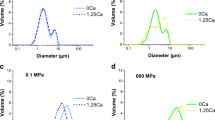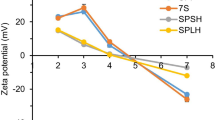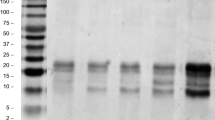Abstract
The effects of pH and NaCl concentration on protein solubility, emulsification, and foamability of sesame protein concentrate from dehulled seeds were investigated. The protein content of the concentrate was 70.7%. Protein solubility, emulsion, and foaming capacities varied with pH and ionic strength. Protein solubility, which was least at pH 4, (2.1%) ranged from 6.6% at pH 2 to 13.1% at pH 10. The solubility increased with increase in ionic strength, ranging from 9.8% at 0.0 M to 16.1% at 1.0 M concentration. The emulsion capacity ranged from 6.2 mL oil/g sample at pH 2 to 19.4 mL oil/g sample at pH 10. The emulsion capacity increased from 11.5 mL oil/g sample at 0.0 M to 20.9 mL oil/g sample at 1.0 M salt concentration. Stability of the emulsion increased with increase in NaCl concentration, ranging from 42% at 0.0 M concentration to 70% at 1.0 M concentration, but 0.5 M NaCl produced the most stable foam after 120 min of whipping while the least stable was at 1.0 M.
Similar content being viewed by others
References
Nilo Rivas, R., J.E. Dench, and J.C. Caygill, Nitrogen Extractability of Sesame (Sesamum indicum L.) Seed and the Preparation of Protein Isolates,J. Sci. Food Agric. 32:565–571 (1981).
Kinsella, J.E., and R.R. Mohite, The Physicochemical Characteristics and Functional Properties of Sesame Proteins, inNew Protein Foods, Vol. 5, edited by A.M. Altschul and H.L. Wilcke, Academic Press Inc., New York, 1985, pp. 435–456.
Johnson, L.A., T.M. Suleiman, and E.W. Lusas, Sesame Seed: A Review and Prospects,J. Am. Oil. Chem. Soc. 56:463–468 (1979).
Wolf, W.J., Soybean Proteins: Their Functional, Chemical and Physical Properties,J. Agric. Food Chem. 18(6):969–976 (1970).
Kinsella, J.E., Functional Properties of Soy Proteins,J. Am. Oil Chem. Soc. 56:244–258 (1979).
Abou El-Khier, Y.I.A., Y.C. Mohorran, and H.O.A. Osman, Effect of Decortication on the Quality of Sesame Kernel and Products,J. Food Agric. 1(3):163–168 (1987).
Campbell, M.F., C.W. Kraut, W.C. Yackel, and H.S. Yang, Soy Protein Concentrate, inNew Protein Foods, Vol. 5, edited by A.M. Altschul and H.L. Wilcke, Academic Press Inc., New York, 1985, pp. 302–335.
Official Methods of Analysis, 14th edn., Association of Official Analytical Chemists, Washington, D.C., 1984.
Ihekoronye, A.I., and P.O. Ngoddy,Integrated Food Science and Technology for the Tropics, MacMillan Publishers, London, 1985.
Sathe, S.K., and D.K. Salunkhe, Functional Properties of the Great Northern Bean (Phaseolus vulgaris L.) Proteins: Emulsion, Foaming, Viscosity and Gelation Properties,J. Food Sci. 46:71–74 (1981).
Okezie, B.O., and A.B. Bello, Physicochemical and Functional Properties of Winged Bean Flour and Isolate Compared with Soy Isolate,J. Food Sci. 53(2):450–455 (1988).
McWatter, K.H., and M.R. Holmes, Salt Concentration, pH and Flour Concentration Effects on Nitrogen Solubility and Emulsifying Properties of Peanut Flour,44:765–769 (1979).
Dench, J.E., Extraction of Nitrogenous Material from Winged Bean (Psopholarpus tetragonolabus L.)_Flour and the Preparation and Properties of Protein Isolates,J. Sci. Food Agric. 33:173–182 (1982).
Abbey, B.W., and G.O. Iben, Functional Properties of Raw and Heat Processed Cowpea (Vigna unguiculata Walp) Flour,J. Food Sci. 53(6):1775–1777, 1971 (1988).
Inyang, U.E., and C.U. Nwadimkpa, Functional Properties of Dehulled Sesame (Sesamum indicum L.) Seed Flour,J. Am. Oil Chem. Soc. 69(8):819–822 (1992).
Franzen, K.L., and J.E. Kinsella, Functional Properties of Succinylated and Acetylated Soy Protein,J. Agric. Food Chem. 24:788–794 (1976).
Ihekoronye, A.I., Functional Properties of Meal Products of the Nigerian “Red Skin” Groundnut (Arachis hypogaea L.),J. Sci. Food Agric. 37:1035–1041 (1986).
Kinsella, J.E., S. Damodaran, and B. German, Physicochemical and Functional Properties of Oilseed Proteins with Emphasis on Soy Proteins, inNew Protein Foods, Vol. 5, edited by A. M. Altschul, and H.L. Wilcke, Academic Press Inc., New York, 1985, pp. 108–179.
Dench, J.E., R. Nilo Rivas, and J.C. Caygill, Selected Functional Properties of Sesame (Sesamum indicum L.) Flour and Two Protein Isolates,J. Sci. Food Agric. 32:357–364 (1981).
Author information
Authors and Affiliations
About this article
Cite this article
Inyang, U.E., Iduh, A.O. Influence of pH and salt concentration on protein solubility, emulsifying and foaming properties of sesame protein concentrate. J Am Oil Chem Soc 73, 1663–1667 (1996). https://doi.org/10.1007/BF02517969
Received:
Accepted:
Issue Date:
DOI: https://doi.org/10.1007/BF02517969




